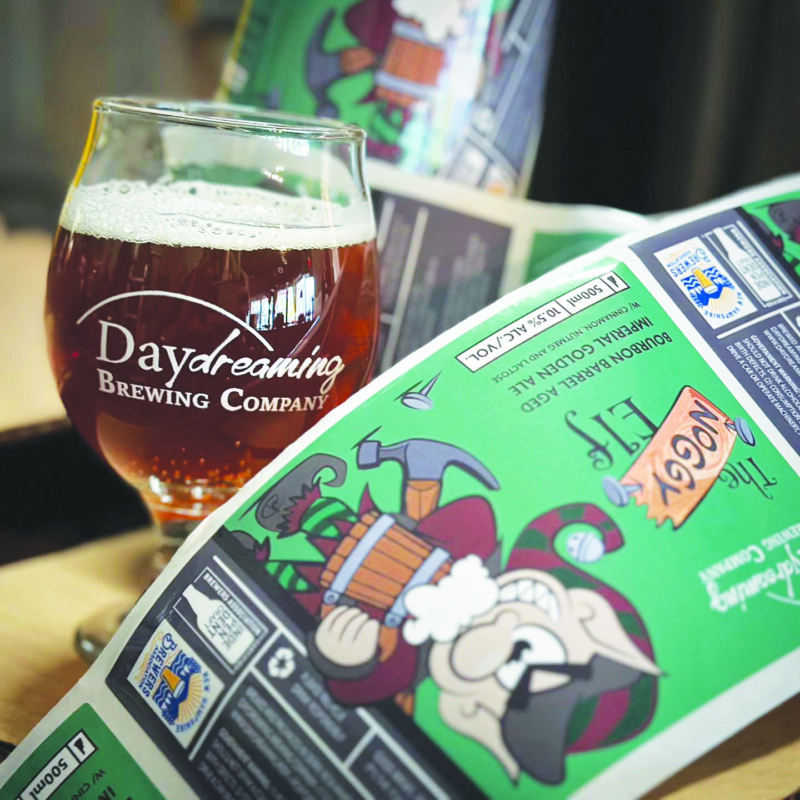A heretofore-mid TSA agent gets tangled up in a terrorist attack in Carry-On, Netflix’s attempt at a “Die Hard is a Christmas movie”-style Christmas movie.
It’s Christmas Eve and Ethan (Taron Egerton) has just learned that girlfriend Nora (Sofia Carson) is pregnant. For the first time since failing to get into the police academy, he’s suddenly motivated to make more of himself at his TSA job at LAX. And lucky him, he gets a chance at working the carry-on bag X-ray machine on a busy Christmas Eve. Unlucky for him, his sudden show of ambition messes with the plans of Jason Bateman (his character is just called “Traveler” on IMDb), who is running some kind of terrorism operation. He had planned to kidnap Ethan’s buddy Jason’s (Sinqua Walls) family to force Jason to let through a bag carrying some clearly dangerous thing but when Jason gives Ethan a shot at the X-ray, suddenly Ethan is the one getting a mysterious ear bud and having a conversation about not calling the cops. Jason Bateman threatens Ethan’s girlfriend and demonstrates his abilities by hurting one of Ethan’s coworkers so Ethan feels like he has no choice but to follow his instructions, while also trying his best to find ways to stop Jason Bateman’s ultimately convoluted-but-who-cares plan.
Carry-On is goofy and I am here for it! “More silly holiday action” is my special Christmas wish; it’s an excellent bit of “goes-with” programming to the holiday rom-coms. Egerton is completely serviceable as a guy forced to step up and be heroic — his abilities are believable enough. Bateman is good fun as a smarmy villain. And Danielle Deadwyler, playing the one cop who knows the score, is a delight; give this woman her own Reacher. She also gets to participate in the movie’s funnest/dumbest action sequence; it’s silly and great. B Streaming on Netflix.
That Christmas (PG)
Santa Brian Cox Claus tells us the story of the English town of Wellington-on-Sea during That Christmas, a sweet animated tale co-written by Richard Love Actually Curtis.
Kids and their families navigate the days before Christmas with an assortment of concerns. Bernadette McNutt (voice of India Brown), of mid-teen-ish age, is eager to break free from the traditions of the season — from zhuzhing up the school nativity pageant to finding something other than the boring turkey dinner for Christmas Day. On Christmas Eve, she’s left to care for her younger sister Eve (voice of Bronte Smith) and neighbor kids Teddy (voice of Freddie Spry), Scarlett (voice of Ava Talbot) and Nisha (voice of Kuhu Agarwal) when Bernie and Eve’s parents (voices of Rosie Cavaliero and Rhys Darby), Teddy and Scarlett’s parents (voice of Alex Macqueen and Lolly Adefope) and Nisha’s mom (voice of Sindhu Vee) head to a wedding for the afternoon.
Meanwhile, Sam (voice of Zazie Hayhurst) is worried that her twin sister Charlie (voice of Sienna Sayer) won’t get anything from Father Christmas because Sam is certain Charlie is on the naughty list. Sam doesn’t fully appreciate that some of Charlie’s pranks are meant to help her get together with Danny Williams (voice of Jack Wisniewski), a new kid who is smitten with Sam as well. Danny, when he isn’t struggling with his new school, is struggling at home with being mostly alone — his hard-working nurse mom (voice of Jodie Whittaker) is often at her job and he hasn’t seen much of his dad since their divorce. When a snow day is called on what would have been the last day of school, Danny winds up spending all of it at the school being one-on-one tutored by the imposing Mrs. Trapper (voice of Fiona Shaw), a teacher who still scares adults she once taught and doesn’t like to show how otherwise alone she is.
When a blizzard rolls in on Christmas Eve, all of these townsfolk — plus Lighthouse Bill (voice of Bill Nighy) and Santa — work together to help the kids have a good Christmas in spite of various suboptimal circumstances and find joy in community. It’s all very good-natured British, very Call the Midwife Christmas special but without the horrifying medical emergencies.
My younger kids were occasionally bored with some of the ramp up to the big day and its blizzard but the last 60 percent or so of the movie held their attention. And it has a nice mix of kid wackiness, silliness involving a flock of turkeys that runs loose and just a touch of snark to help balance out some truly heartwarming Christmas-y-ness. B+ Streaming on Netflix.
Christmas Eve in Miller’s Point (PG-13)
A big, largely-Italian-American family comes together on Christmas Eve for a night of food, light bickering, kid antics and general merriment in Christmas Eve in Miller’s Point.
Someone on Bluesky described this movie as feeling like if Robert Altman made a holiday movie and that is a pretty clean way to explain what you’re getting here. A group of adult siblings and others — cousins, and/or “cousins” in the sense of people who are part of a big family even if it’s not entirely clear how — gather at the home where they grew up, with all of their children, ranging in age from small to adult themselves. The mother (Mary Reistetter) still lives in the house with one of the siblings — who now wants to sell the house and put her in a facility that can better care for her. We get hints at how far along this plan is throughout the movie, putting a general sense over the movie (one that we in the audience might be more aware of than the characters all are) that this could be the last Christmas Eve of this kind for this family.
This is, however, kind of background. Mostly we are just mingling, poking in on conversations between different relatives. We get to the party with Kathleen (Maria Dizzia) and her teenage daughter Emily (Matilda Fleming), her younger son and her husband Lenny (Ben Shenkman). We see some of Kathleen complaining about her prickly relationship with Emily and some of Emily’s “eyeroll, Mom” at Kathleen and at times follow Emily when she and other cousins sneak out and drive around. They meet up with other kids, hang out at a diner, hang out at a place where teens go to make out, try to convince someone to sell them booze. Nothing “happens” in the big-event sense. We get family members reliving annual traditions, we get spreads of food and a big meal, we get teens teen-ing around. We are just spending Christmas Eve with them and experiencing the overheated togetherness of a joyful/obligatory family gathering. Solid performances (including by Francesca Scorsese, Sawyer Spielberg — yes, the kids of that Scorsese and that Spielberg — and Elsie Fisher of Eighth Grade fame) make this a solid hang movie. B Streaming on AMC+ and available for rent or purchase.
Red One (PG-13)
Santa Claus is kidnapped and Dwayne Johnson and Chris Evans have to save Christmas in Red One, the unnecessarily CGI-heavy, grimly quippy, unfun holiday action adventure.
Nick a.k.a. Red a.k.a. Santa Claus (J.K. Simmons, continuing this season’s widely commented on “ripped and/or hot Santa” trend) is kidnapped. An investigation by Callum Drift (Johnson), head of security, and Zoe (Lucy Liu), head of some organization that protects mythological creatures, leads them to Jack O’Malley (Evans), a con artist and hacker. He was paid to sneak into a government office and find the location of what he was told was a weapons test. He didn’t realize that what he was actually tracking was the location of Santa’s cloaked North Pole metropolis. Jack has long been a “no beliefs, no loyalty” guy and agrees to help Callum hunt down his employer (for money).
Eventually, Santa’s brother Krampus (Kristofer Hivju) and a Christmas witch (a real Icelandic thing, according to Wikipedia) called Gryla (Kieran Shipka) are in the mix. Also, Jack finds that the investigation is getting in his way of being even a C-minus dad to his young teen son Dylan (Wesley Kimmel). Mary Elizabeth Ellis plays Dylan’s mom and mostly she just plays a person who delivers exposition on what a crummy parent Jack has been. I mention this because she is often a really fun actress, as in her recent role playing Ted Danson’s daughter on the Netflix series A Man on the Inside, which is a truly funny, sweet show about aging, life phases, family relationships and more and you could watch about of half the season in the time it takes to watch this movie, which I think is a better use of your two hours.
Here, we get a chase through the streets of the North Pole, a Santa’s workshop staffed by penguins and bears, magic portals and other Santa lore stuff that probably could be fun but here just feels like mid-quality CGI for the sake of CGI. This is particularly noticeable with Krampus, a character that is given a Hulky-Thanosy outsized demonic body, which actually gets in the way of what could have been a personable performance by Hivju, who you may remember as Tormund Giantsbane on Game of Thrones. He is a fun actor playing a fun character but it’s so buried in nonsense that you don’t get to get a real sense of him or his relationship with Santa.
This movie feels very much “Marvel but Christmas” in the worst sense of that description (unlike The Guardians of the Galaxy Holiday Special, an actual Marvel holiday product which is goofy and delightful and is available on Disney+). It also straddles a weird line of being more violent and creature-scary than you’d want your kid movie to be but doesn’t offer much for adults. C- In theaters and streaming on Prime Video.
Hot Frosty (TV-PG)
A sad widow falls in love with a ripped snowman in Hot Frosty, the delightfully bonkers but not winky holiday rom-com from Netflix.
Kathy Barrett (Lacey Chabert), who runs the diner in downtown Hope Springs, is mourning the loss of her husband and doesn’t have the mental energy for things like fixing her house’s many repair issues or looking for new romance. Her friend at the local consignment store gives her a good-luck red scarf to encourage her to get back out there. But sad Kathy just ends up putting the scarf on a snowman in the town square, one who has a well-chiseled set of abs. Later that night — through the Magic of Christmas!, probably — the snowman becomes a human, though one with a very cold resting temperature and a tendency to sweat profusely when exposed to even minor warmth. Jack (Dustin Milligan, Josh the podcaster from the excellent Rutherford Falls), as this “man” is eventually called, isn’t sure about much — like, if he can melt or how clothes work or how eating works — but he is certain he is very fond of Kathy. Not exactly sure what Jack’s deal is, Kathy just sort of goes with the whole “I used to be a snowman” thing and lets Jack crash at her house, in part to hide him from the sheriff (Craig Robinson). When Jack came alive, he accidentally streaked in front of an older couple, broke a window in the consignment store and took some coveralls — a crime spree the sheriff and his deputy (Joe Lo Trugilo) just can’t countenance.
There are a lot of little goofy moments in and aspects of this movie that are played perfectly straight in a way that made me truly enjoy this bit of holiday fluff: Jack excitedly telling the other (non-alive) snowmen in the town square that maybe “it could happen” for them too. Craig Robinson’s increasingly Inspector Javert-like obsession with finding the man who crimed up his one-street town. Joe Lo Trugilo, still basically Brooklyn Nine-Nine’s Charles Boyle, answering “how does some soup sound?” literally. Lacy Chabert never once winking at the audience. Dustin Milligan giving “beautiful dummy” without playing his character as too witless. Either you’re going to buy into “lady falls for ripped snowman” or you can’t. But if you do, you’ll be rewarded by this movie that has fun with, without making fun of, its silly premise. B Streaming on Netflix.
The Merry Gentlemen (PG)
Chad Michael Murray PG-ily The Full Montys (“full” in this case being “shirtless in jeans, sometimes Speedos”) to save Britt Robertson’s family’s nightclub in The Merry Gentlemen.
After being fired from her Rockettes-like Broadway show in New York City, Ashley (Robertson) returns to her hometown to find that her parents (Michael Gross and Beth Broderick) are behind on their rent for their nightclub, the Rhythm Room — which is also not exactly mobbed with customers. Ashley comes up with an idea to quickly earn the $30K her parents owe and save their business: a male revue of sexy men sexy dancing. She enlists/enforces Luke (Murray), the club’s volunteer handyman who is also a woodworking artisan, to join along with a few other guys. Using her dancer skills, she helps teach the boys routines that bring in the crowds of local ladies, politely whooping it up from their seats as the men enchant them from the stage only, no touching.
This is a totally solid and watchable cast and the premise had the promise of some Hot Frosty fun, but this movie is missing the daffiness that made that movie such a treat. It is also, like many of this genre of movie, quite sexless — a thing that just is what it is for these children-of-Hallmark but which really sticks out with this movie’s premise. Also, despite its just under 90-minute runtime, the movie drags a bit and feels like it would be best enjoyed as a thing on in the background while you’re doing something else. C+ Streaming on Netflix.
The Night Before Christmas in Wonderland (7+)

Santa Claus attempts to make a delivery to Wonderland and runs into the very anti-Christmas Queen of Hearts in The Night Before Christmas in Wonderland, a prettily-animated sweetness-with-a-hint-of-tart animated adaptation of the book by Carys Bexington and illustrated by Kate Hindley.
Just as he’s about to set out on Christmas Eve, Santa Claus (voice of Gerard Butler) gets a last-minute letter from a young princess in Wonderland asking for a Bandersnatch. He decides to rework his flight plan to make a little stop in Wonderland — over the objection of the skeptical reindeer — but, Wonderland being Wonderland, he and the reindeer and an elf who tagged along are quickly waylaid in their task. In addition to mazes with rooms that seem to defy physics and potions that make you big or small, Santa and company find their present-delivering task made harder by the Queen of Hearts (voice of Emilia Clarke), who hates Christmas and every tinsel and pudding and (because this is the United Kingdom) Christmas cracker that reminds her of the holiday.
Also because it’s the U.K., the movie has nice notes of acid through all the holiday sweetness — the reindeer who are a bit cynical office workers for a somewhat scatterbrained boss, the silliness of the Wonderland characters like the March Hare (voice of Asim Chaudhry) and the Mad Hatter (Mawaan Rizwan), the elf band that pops up everywhere to add mood music to scenes. Clark makes for a fun mad Queen and Gerard Butler is a surprising Santa choice but he works. And throughout the movie has lovely storybook animation that adds notes of humor to the full-color prettiness. B+ Streaming on Amazon Prime Video.
Dear Santa (PG-13)
An 11-year-old with a tendency toward misspelling accidentally sends his letter with his fondest wish to Satan in Dear Santa.
Liam (Robert Timothy Smith) is having a hard time with life — he’s not really fitting in at his new school, his parents are constantly fighting and the family is still struggling with a recent tragedy. He does have a good friend, Gibby (Jaden Carson Baker), and a crush — Emma (Kai Cech), who is nice but who Liam can’t figure out how to be normal around. He writes to Santa, really just because the ritual gives his mom a bit of cheer, but due to some spelling difficulties it’s addressed “To: Satan, North Lope” and is received in the hot place by Jack Black. Tickled that a kid has written to him, Satan appears, all devil horns and stinkiness, to grant Liam’s wishes. It takes Liam a bit to realize he’s dealing with Old Nick, not Saint Nick, but eventually he learns the terms of the deal: he makes three wishes, the devil gets his soul. No, thank you, Liam says. But without realizing who he was dealing with, he already made one wish — for Emma to give him a chance. The wish is a pretty deluxe package deal — VIP tickets to a Post Malone concert, with sweet transportation and even a ticket for Gibby. But Liam is loath to make another wish and lose his soul.
Dear Santa is a bit of a Farrelly Brothers joint — Bobby directs, Peter has a screenplay co-writing credit and both have producer credits. Though this movie is PG-13, it has moments of R-rated-seeming comedy that are more in line with their early R movies than a more family-friendly comedy. The movie also has some real lesser-quality Disney-sitcom vibes — the kids and the material are largely not a good fit. The young actors oftentimes can not sell the comedy they’re given and/or aren’t given comedy that they can make work, leading to some very tinny, artificial scenes. Add in yikes-some acting by Brianne Howey and Hayes MacArthur as Liam’s parents, and this feels more toss-off TV movie than the Farrelly Brothers presence and Jack Black’s leading role would suggest. The movie’s main problem, I think, is that it’s not solidly a family comedy or solidly a Bad Santa-esque R-rated comedy. Either could have worked but this middle way leaves the movie mushy and underbaked. C- Streaming on Paramount+ and available for rent or purchase.
Nutcrackers (PG-13)
Businessman Ben Stiller finds himself caring for his four semi-feral nephews in the mournful but sweet Nutcrackers.
Michael (Stiller) feels like a stock 1980s comedy character, with his “Big Presentation” deadline looming and his big-city ways and his inability to cope without wi-fi (which would have been, what, a fax machine in a 1980s movie?). When his sister and her husband died, he sent an Edible Arrangement to the funeral for his four young-teen-through-young-elementary -age nephews (Homer Janson, Arlo Janson, Ulysses Janson and Atlas Janson). Now he is headed to their rural working family farm to sign some papers and get them adopted or something — it’s not clear what he thinks is happening with the kids and the farm but “not it” is very clearly his position. Social worker Gretchen (Linda Cardellini) tells him that she doesn’t have a family willing to take all four boys yet and Michael needs to stick around to care for them for what he clearly thinks will be more days than weeks. With their long hair, their home-schooled farm-focused lives and their general brotherness, the Kicklighter boys are known as sort of a handful. Their mom/Michael’s sister was, however, beloved in the town for her dance studio. Eventually, Michael hits on the idea of them putting on a kid-penned variation on the Nutcracker to show everyone how adorable and adoptable the boys are.
Stiller here is fine — the right amount of prickly for a guy who doesn’t have child experience and had been estranged from his sister but not cartoonishly heartless. But it’s the Janson boys, real-life brothers, who give the movie heart. They play the boyness of their characters — a constant whirl of wrestling, bad decisions, general messiness, loyalty and surprising moments of kindness — in a way that feels genuine and will be instantly recognizable to anybody who has parented or taught or otherwise attempted to corral more than one boy. B- Streaming on Hulu.
Mary (TV-14)
The Christmas story is the focus of Mary, a biography of the early years of Jesus’ mom.
The standard nativity pageant story is not generally feature-length so this movie starts with the difficulties Mary’s parents Joachim (Ori Pfeffer) and Anne (Hilla Vidor) have conceiving in 18 B.C. Nazareth. Blue-robed Archangel Gabriel (Dudley O’Shaughnessy) shows up to Joachim and Anne to tell them that God will give them a daughter, with conditions. Years later, their daughter Mary (Mila Harris) is elementary-aged and when Gabriel shows up again mom and dad know it’s time to take Mary to the temple where she will serve God, as they’ve agreed. Mary spends years at the temple (long enough to age up into actress Noa Cohen), mostly doing housekeeping stuff with a similarly aged group of girls and under the mentorship of Anna (Susan Brown), who feels a bit like she’s on loan from the Bene Gesserit. One day, stoneworker Joseph (Ido Tako), with a little heavenly nudging, sees Mary doing the laundry at a nearby river. Their interaction includes only Mary telling him the name of her father and also calling him crazy for wading into the river to get her shawl. But Joseph decides she’s the one for him and asks Joachim for her hand in marriage. Mary’s parents aren’t sure but then he mentions getting some directions from the blue-robed guy and they give him the thumbs up. Mary is more-or-less OK with the engagement but then she gets her own visit from Gabriel and is told that she is “with child.” The wider community is really jerky about Mary’s single mom-to-be status and Joseph has to decide what he wants to do about it.
Extremely meanwhile, King Herod (Anthony Hopkins, very “angry Odin” but bigger and louder and more bonkers) is busy restoring the temple, murdering his wife, acting twitchy about his place in the Roman power structure and just generally being a pretty unhinged guy. When he crosses paths with Mary, he has a sort of prophetic-vision-reaction, leading his main bodyguard (Gudmundur Thorvaldsson) to get all obsessed with hunting down this random teen who gave the stink-eye to his boss.
I enjoy a good Bible story movie, particularly if the movie takes a Ridley-Scott-with-the-Gladiator-movies “sure, whatever” approach to historical accuracy and has at least one character who decides to go full Shakespeare-at-top-volume theatrical. This movie has all of those things: the costuming here feels more galaxy far, far away than Earth a long, long time ago; Anthony Hopkins goes All In as Herod, and I do not remember the Bible having as many action scenes for Mary and Joseph as we see here. Are Mary’s eyebrows way too on point for a pregnant lady in antiquity? Yes, but that doesn’t mean that it isn’t a fun watch. B- Streaming on Netflix.
An Almost Christmas Story (PG)
A young owl ends up in the Christmas Tree in Rockefeller Center in An Almost Christmas Story, a visually lovely animated movie.
According to Wikipedia, this is actually computer-generated animation but the visuals suggest paper craft (cars and buildings that seem to be made of cardboard, puffs of steam that look drawn on paper) and characters with a wooden puppet or papier mache look. Their movements suggest stop-motion animation and puppetry — it’s all very well done and helps give a kind of tactile warmth to the story.
Little owl Moon (voice of Cary Christopher) does not, as his father, Papa (voice of Jim Gaffigan), tells him, stay put while his father flies off to look for shelter and instead flies out to look for sticks to fix the family nest. A hawk chases Moon, who falls and hurts his wing, and Papa hurries Moon into a random tree and says to wait for him. Before Papa can get back, though, the tree is cut down and winds up at Rockefeller Center, decorated for Christmas and sitting next to the ice rink. When Moon ventures out of the tree, he winds up falling into Luna (voice of Estella Madrigal) a young girl with a prosthetic leg attempting to relearn to ice skate. After some adventures through the subway while being chased by pigeons (voices of Mamoudou Athie, Philip Rosenthal and Natasha Lyonne) who think Moon is trying to steal their garbage food, Moon and Luna end up wandering around, each lost and trying to seek their family.
The movie (which clocks in at 21 minutes) is a celebration of human (and animal) kindness. Its real highlights are the beautiful animation style and the very fun and fitting voice work, with standouts being Lyonne and John C. Reilly as a narrator of sorts. B+ Streaming on Disney+.






